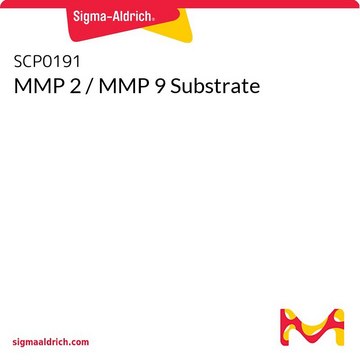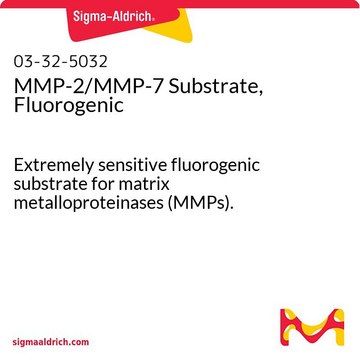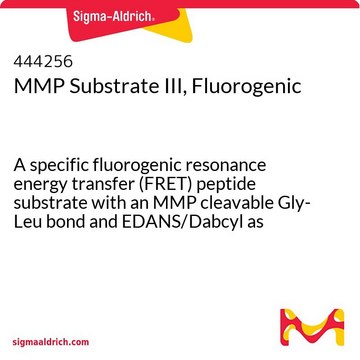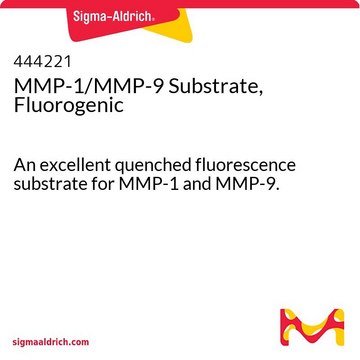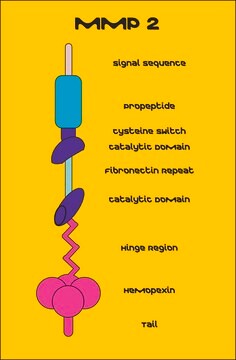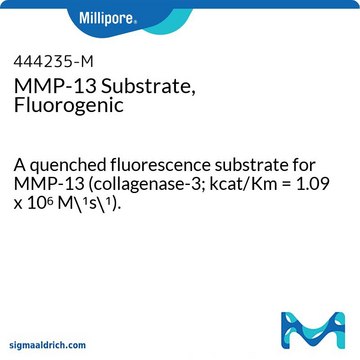SCP0193
MMP Substrate
≥95% (HPLC), lyophilized
Synonym(s):
FS-6
Sign Into View Organizational & Contract Pricing
All Photos(1)
About This Item
Empirical Formula (Hill Notation):
C55H80N16O16
Molecular Weight:
1221.32
UNSPSC Code:
12352200
NACRES:
NA.32
Recommended Products
Product Name
MMP Substrate,
Assay
≥95% (HPLC)
form
lyophilized
composition
Peptide Content, ≥75%
storage condition
protect from light
storage temp.
−20°C
Amino Acid Sequence
MCA-Lys-Pro-Leu-Gly-Leu-DNP-Dpa-Ala-Arg-NH2
General description
Matrix Metalloproteases (MMPs) belongs to the zinc metalloprotease family M10. They are zinc-dependent, calcium-containing hydrolases.
Biochem/physiol Actions
Matrix Metalloproteases (MMPs) are involved in extracellular matrix (ECM) degradation. MMPs regulate cellular and disease processes. They are implicated in processes such as cell proliferation, migration, differentiation, angiogenesis, anti-inflammatory response, vasoconstriction, apoptosis and host defense. Dysregulation of MMP is associated with arthritis, ulcers, encephalomyelitis and cancer.
The peptide MCA-Lys-Pro-Leu-Gly-Leu-DNP-Dpa-Ala-Arg-NH2, or FS-6, is a fluorogenic substrate for several matrix metalloproteinases (MMPs). FS-6 is a water-soluble, modified form of the well-established MMP substrate FS-1, where a lysine residue has been added to the N-terminus of FS-1. The resulting FS-6 has been reported to give a peptide with improved kinetic properties for several MMPs, including MMP-1, MMP-8, MMP-13, and MMP-14, compared to FS-1. This MMP substrate has also been described as a particularly useful substrate for the zinc metalloproteinase tumor necrosis factor-α converting enzyme (TACE or ADAM-17). FS-6 can be used to measure metalloproteinase activity in tissue culture conditions, for example, on the surface of viable cells in situ.
Storage Class Code
11 - Combustible Solids
WGK
WGK 3
Flash Point(F)
Not applicable
Flash Point(C)
Not applicable
Choose from one of the most recent versions:
Certificates of Analysis (COA)
Lot/Batch Number
Don't see the Right Version?
If you require a particular version, you can look up a specific certificate by the Lot or Batch number.
Already Own This Product?
Find documentation for the products that you have recently purchased in the Document Library.
Customers Also Viewed
Ulf Neumann et al.
Analytical biochemistry, 328(2), 166-173 (2004-04-29)
Matrix metalloproteinases (MMPs) and the related tumor necrosis factor converting enzyme (TACE) are involved in tissue remodeling, cell migration, and processing of signaling molecules, such as cytokines and adhesion molecules. Fluorescence-quenched peptide substrates have been widely used to quantitate the
MMP-12 catalytic domain recognizes triple helical peptide models of collagen V with exosites and high activity.
Bhaskaran R
The Journal of Biological Chemistry, 283(31), 21779-21788 (2008)
Knowledge-transfer learning for prediction of matrix metalloprotease substrate-cleavage sites
Wang Y, et al.
Scientific Reports, 7(1), 5755-5755 (2017)
Hideaki Nagase et al.
Cardiovascular research, 69(3), 562-573 (2006-01-13)
Matrix metalloproteinases (MMPs), also called matrixins, function in the extracellular environment of cells and degrade both matrix and non-matrix proteins. They play central roles in morphogenesis, wound healing, tissue repair and remodelling in response to injury, e.g. after myocardial infarction
Our team of scientists has experience in all areas of research including Life Science, Material Science, Chemical Synthesis, Chromatography, Analytical and many others.
Contact Technical Service